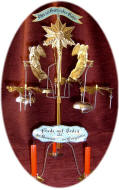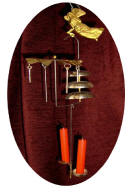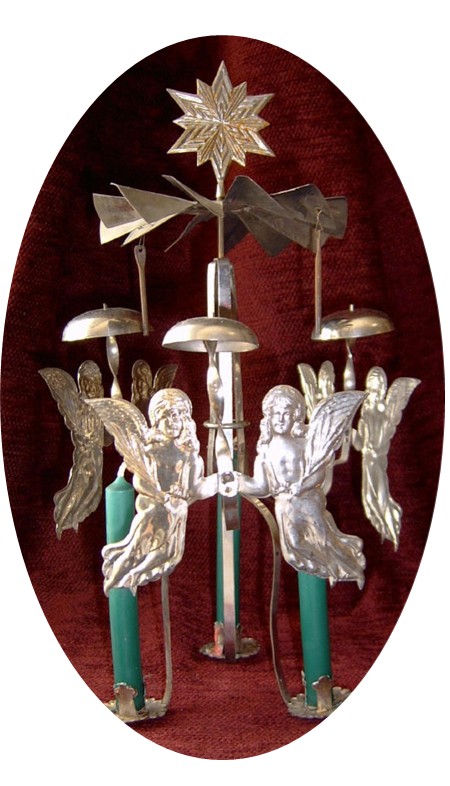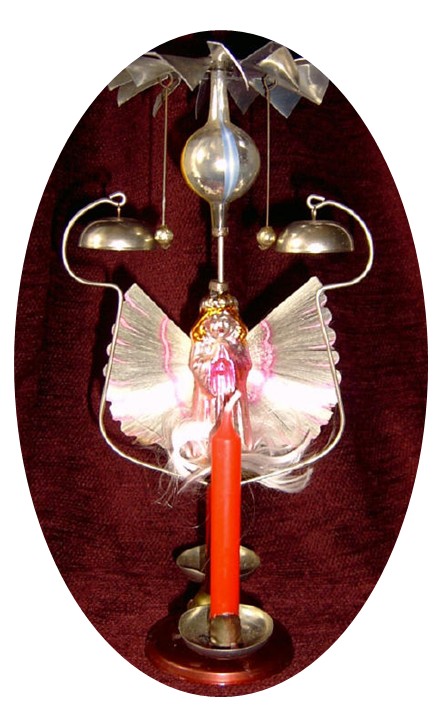|
The Collection continued:
II. Other Early Angel Chimes
|
Unidentified Candle
Chime
An
example of Stock’s contemporary competition in the
candle chime market, reproduced from Schulte-Kellinghaus.
Although details such as age and manufacturer are
frustratingly difficult to determine for these early
chimes, it is at least fairly easy to tell Adrian &
Stock products from those of other makers: in all Adrian
& Stock chimes, the angels carry the bell-clappers, and
are always suspended (or “floating”) from the impeller:
these were Stock’s exclusive patents.

Early Advertisements
for Candle Chimes
Also shown are two contemporary advertisements for other
competing candle chimes, reproduced from 1904 issues of
the magazine Berliner Illustrierte. As
documentary evidence they are a bit frustrating, in that
the highly stylized representations of angels floating
around a Christmas tree are difficult to match with any
particular candle chime. The angels pictured in the
first advertisement, headed “Christbaum-Geläut”
(Christmas tree chime) bear a tantalizing resemblance to
those in the “Stern von Bethlehem” chime discussed
below. The second advertisement is interesting for two
reasons. The text, with its heading “Fort mit den
Glas-Christbaum Spitzen!” (Away with glass Christmas
tree toppers!) illustrates a strong selling point for
these new metal chimes: unlike glass tree toppers, they
were unbreakable. Secondly, the sketchy illustration
bears a strong resemblance to the Engels/Keydel candle
chime discussed below, which, as we shall see, is
further evidence of a strong German-American trade
connection.
|
|
 Rauh
Bros.
“Engel-Geläute Stern von Bethlehem” (Angel-Chimes with the Star of
Bethlehem) (43 x 24 cm.) Rauh
Bros.
“Engel-Geläute Stern von Bethlehem” (Angel-Chimes with the Star of
Bethlehem) (43 x 24 cm.)
Engel-Geläute
“Stern von Bethlehem” (Angel-Chimes with the Star of Bethlehem).
Based on the box of an example sold
 recently
on eBay (see photo, left), manufacture of this extraordinary chime
may be tentatively attributed to the firm of Gebrüder Rauh, one of
many makers of cutlery and metalware based in Solingen. The exact
date of manufacture is unknown, but the artwork on the box of this
and other examples would indicate a date between 1890 and about
1910. (But note this detail, pictured on the right, from a 1904
advertisement for an otherwise unidentified chime, whose stylized
angel figures resemble those in the “Stern von Bethlehem” chime.)
The chime was apparently quite popular, and widely distributed:
boxes have been noted with the names of a number of different
Solingen retailers, including recently
on eBay (see photo, left), manufacture of this extraordinary chime
may be tentatively attributed to the firm of Gebrüder Rauh, one of
many makers of cutlery and metalware based in Solingen. The exact
date of manufacture is unknown, but the artwork on the box of this
and other examples would indicate a date between 1890 and about
1910. (But note this detail, pictured on the right, from a 1904
advertisement for an otherwise unidentified chime, whose stylized
angel figures resemble those in the “Stern von Bethlehem” chime.)
The chime was apparently quite popular, and widely distributed:
boxes have been noted with the names of a number of different
Solingen retailers, including
I. Ranges, and Emil Jansen.
Although
angels are an integral part of the design, they do not act as bell
ringers but as supports for an ingenious system of counter-balanced
chimes and and impellers. The directions indicate that the chime was
meant to function both as a tree-topper and as a table display, but
in fact it can be safely displayed on a tabletop only with some kind
of stand. The hand-shaped candle-holder is unique to this maker, as
is the chime/clapper/impeller system. The counter-balance mechanism
is a useful innovation, since gravity keeps the chiming parts
reasonably level even if the whole device is out of plumb (as is
usual with your average Christmas tree). Early advertisements for
this chime proudly state that “every piece is guaranteed to function
perfectly,” and indeed, it is one of the very few early models of
angel chimes that can be made to work reliably today without endless
tinkering. Two design variants have been noted, the differences
lying primarily in the lettering on the banner and cloud. The one
shown here, with its box, is in unusually pristine condition.
|
 Rauh
Bros.
“Engel-Geläute,” (Angel-Chimes)1-bell (31 x 12 cm.) and 3-bell (41 x 13 cm.)
versions. Rauh
Bros.
“Engel-Geläute,” (Angel-Chimes)1-bell (31 x 12 cm.) and 3-bell (41 x 13 cm.)
versions.
Although the
boxes bear no maker’s mark, these tree
ornaments are also almost
certainly by Rauh. They incorporate the same odd hand-shaped candle
holders, distinctive angels, and a similar — but even more elaborate
— counter-balanced mechanism of candle, impeller, and chime.
The 1-bell chimes (first five photos below), powered
by a single candle, came three to a box; the 3-bell version (final
two photos below), which ran on two candles, was sold singly.
|
 Engels
"Christbaumgeläute" (Christmas Tree Chimes) Engels
"Christbaumgeläute" (Christmas Tree Chimes)
(28.5 x 16 cm.)
Keydel “Angel Chimes” (28.5 x 16 cm.)
Perhaps the
earliest German candle chime imported to America was this "Christbaumgeläute" (Christmas tree chimes),
which according to the instruction leaflet was manufactured in
Solingen by (appropriately
enough) Friedrich Wilhelm Engels, and distributed in the United
States by Joseph P. Steiner of Milwaukee, WI. (Milwaukee had large
population of recent German immigrants at this period.) The chime
appears almost identical to the "Christbaumspitz" in the 1904
advertisement described above. Although the advertisement is
associated with a different Solingen merchant — Paul Kratz — the
illustrations are very similar, and the fact that both documents
dwell on the "unbreakable" nature of the product is significant. As
first imported to America, the chime came disassembled and folded in
a small plain box, and featured a distinctive 12-pointed silver
star. Note the picture of the chime used as a tree topper,
reproduced from the original instruction/advertising leaflet.
(Christmas tree chimes),
which according to the instruction leaflet was manufactured in
Solingen by (appropriately
enough) Friedrich Wilhelm Engels, and distributed in the United
States by Joseph P. Steiner of Milwaukee, WI. (Milwaukee had large
population of recent German immigrants at this period.) The chime
appears almost identical to the "Christbaumspitz" in the 1904
advertisement described above. Although the advertisement is
associated with a different Solingen merchant — Paul Kratz — the
illustrations are very similar, and the fact that both documents
dwell on the "unbreakable" nature of the product is significant. As
first imported to America, the chime came disassembled and folded in
a small plain box, and featured a distinctive 12-pointed silver
star. Note the picture of the chime used as a tree topper,
reproduced from the original instruction/advertising leaflet.
By the mid-to-late 1920s the Keydel
Company of Detroit, MI had taken over the U.S. distribution of this
chime, and perhaps the manufacture as well. As marketed by Keydel,
the chime had a smaller, six pointed gilt star, and came almost
fully assembled in a larger box decorated with lithographic images
and text. The box says ‘patents applied for,’ but no American patent
for this candle chime has yet come to light. However, in 1923 Keydel
did successfully patent an electrically-powered angel chime, which
was produced and marketed at about the same time as this later
version of the candle chime. [Click
Here to see the Keydel
Electric Angel Chimes]. The nickel-plated angel figures on this
chime are attractively and delicately modeled in low relief, and the
bells have a particularly sweet tone. It was manufactured for nearly
thirty years (a long life-span for a product of this kind), and by
the time Keydel began marketing the chime in the U.S. the molded
figures had lost much of their fine detail — collectors will prefer
the earlier German version whenever possible.
|
|
 Heli
“Christbaumwunder” (Christmastree-Miracle) (28 x 14 cm.) Heli
“Christbaumwunder” (Christmastree-Miracle) (28 x 14 cm.)
The bases of
these angel chimes are marked “Heli,” either a company name, a model
reference to the rotating impeller, or both. Originating in the
1920s or 1930s, and produced at least through the 1950s, these
“Christmastree-Miracle” models feature blown-glass angels and
spindles made in the famous glass Christmas ornament workshops at
Lauscha in eastern Germany. The angels have spun-glass wings; the
impellers carry the bell-clappers. Using a glass spindle was a
brilliant idea: metal spindles tend to lose their sharp tips after a
while, causing the chime to slow down or stop working entirely.
These still work perfectly. The instruction sheet shows other models
incorporating Lauscha glass ornaments produced by this firm.
|
|
































